|
WORLD INFO
• World Main
FIREARMS
•Crossbows
•Handguns
•Heavy
•Long Guns
•Machineguns
•Riot
•Sniping
•Submachineguns
MELEE
•Axes
•Chains/Sticks
•Clubs
•Enhancers
•Knives
•Powered
•Spears/Staves
•Swords
RANGED
•Archery
•Axes
•Exotics
•Knives
•Slings
•Shuriken
© 1996-2008
aethereal FORGE

|
|
Colt/Fabrique Nationale M16A2 Assault Rifle
|

|
Weight: 8.8 lbs (4.0kg)
Price Range: C21000-23000
Damage Modifier: x12
|
Type: Conventional Assault Rifle
Range: Eff. (Point) - 1804 feet (550m)
(Area) - 2624 feet (800m)
Max. - 3234 feet (985m)
Magazine Capacity: 10/20/30-Round Clip/
200-Round Drum, 5.56mm
NATO (223 Winchester)
|
The last widely-produced battle rifle in the series based on the 1960's-era
Armalite AR-15 (M16) design, the M16A2 was adopted as the standard for the
US military in 1982 and fielded until replaced by the Objective Individual
Combat Weapon (OICW) beginning in 2007. As a series, the M16 held the
distinction of being the weapon fielded longest ever in the history of the
American military.
During its heyday, the M16A2 was considered the world-wide standard by which
other assault rifles were measured. Light, accurate (for the time), and with
a controllable three-round burst providing a good rate of fire, the M16A2
served admirably as a combat weapon. The single major fault with the M16
series was its tendency to jam if any dirt entered the receiver, and thus
had to constantly be cleaned to be effective.
The M-16 series was put in service around the world, and thus can still be
found regularly on the firearms market even today, though the condition can
vary drastically. Thanks to the popularity of the AK-173 and FN-122 rifles,
no first or even second rate armies still use these weapons, but some third
world countries still use "hand-me" down rifles procured from other nations.
|
|
Kalashnikov AK-74/AK-101 Assault Rifle
|
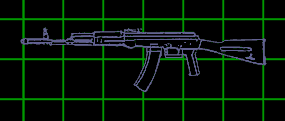
|
Weight: 7.5 lbs (3.4kg)
Price Range: C19000-21000/23000-25000
Damage Modifier: x12
|
Type: Conventional Assault Rifle
Range: Eff. (Point) - 328 feet (100m)/
984 feet (300m)
(Area) - 1804 feet (550m)/
3280 feet (1000m)
Max. - 4920 feet (1500m)
Magazine Capacity: 30-Round Clip, 5.45mm
|
During the United States-Vietnamese Conflict of the 1960's and 70's, the
Soviet Union evaluated its venerable AK-47 rifle against American M-16s
their communist allies in Vietnam had captured. Finding the 5.56mm round
used in the M-16 to be more effective than their own 7.62mm cartridge
despite the disparity of size, the Soviets set out to develop a similar
cartridge. In 1973, the result was the 5.45mm round, and the AK-74 was
produced. The new rifle used the same mechanics, and was essentially an
AK-47 reworked to adopt this smaller chambering, adding a muzzle brake to
keep the weapon controllable with the new round.
The AK-74 became the primary service weapon of the Soviet and then the
Russian Military after the Soviet Union dissolved. It stayed in service
until the mid-1990s, when it was replaced by the updated AK-100 series
featuring more durable synthetic stocks (instead of wood) and superior
accuracy. The AK-100 series also included other chamberings to recapture the
export markets lost to western manufacturers and countries who did not wish
to convert to the 5.45mm round. The AK-101's siblings included the AK-102 in
5.56mm NATO and the AK-103 in 7.62mm R, which had superior firing properties
but were not produced in great quantity.
The AK-47 derivative line of firearms was the most widely produced series
ever. From the beginning of production in 1947 until its end in 2033, more
than 60 million rifles of the series were manufactured before the all-new
AK-133 replaced them in 2033. Though they are no longer common in world
military service, the AK-74 and AK-100 series rifle and ammunition remain
prevalent in the backwaters of the world. Variants of both rifles also exist
in wireframe folding-stock versions.
|
Alliant Techsystems OICW
(Objective Individual Combat Weapon)
|
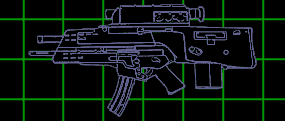
|
Weight: 13.4 lbs (6.0kg)
Price Range: C19000-22000
Damage Modifier: 5.56mm NATO - x12
20mm Grenade - x45
|
Type: Conventional Assault Rifle/Defilade
Airburst Grenade Launcher
Range: 5.56mm NATO-
Eff. (Point) - 2132 feet (650m)
(Area) - 2624 feet (800m)
20mm -
Eff. - 3280 feet (1000m)
Magazine Capacity: 30-Round Clip,
5.56mm NATO
8-Round Clip, 20mm
HE Airburst Projectile
|
The Objective Individual Combat Weapon (OICW) is the Army's first 21st
century individual soldier weapon. Having actually begun development in the
late 1990's, it was prototyped, tested, and fielded in the first decade of
the century. The project generated a great deal of controversy in the
military's ranks for a number of reasons, including its large weight and
size, steep price tag of both weapon and the 20mm ammunition it fired, and
its functional characteristics.
The OICW was a first of its kind. The two features that were its primary
selling points were 1) a optoelectric sighting system featuring a laser
rangefinder and computerized fire control system; and 2) a programmable
airburst grenade launcher designed to hit targets out of the line of sight
by firing a "smart grenade" to airburst at the target's range without an
impact. These developments were predecessors to modern thermoptic sighting
systems and guided projectiles.
The OICW did not receive a warm reception when it was first fielded in 2007.
Problems with the sighting system plagued early models once they became
subjected to the rigors of field use. Furthermore, at the cost of $25 (20
credits) per 20mm round, the weapon was viewed in bad light by commanders
already pinched for funding. New squad tactics also needed to be developed
to incorporate the abilities of the weapon, and this created resentment and
friction throughout the ranks.
However, the OICW was eventually accepted as old heads moved up and out. The
rifle proved capable even if somewhat difficult to maintain. The OICW came
into its own on the tactical battlefield, where the grenade system's
firepower proved instrumental.
Quite a few OICWs are still available, though many lack operational sighting
systems or may be missing components. The base weapon is still quite viable,
though the 20mm cartridges for it are quite rare and are generally left over
from stockpiles manufactured during World War III. Caseless ammunition will
not load into the OICW, nor is it practical to adapt the 20mm system to do
so. However, since the OICW is modular, it is not uncommon to see the OICW
used with the original sighting module stripped off and replaced with iron
or modern sights.
|
|
Mossberg M9200A1 Shotgun
|

|
Weight: 7.3 lbs (3.3kg)
Price Range: C14000-16000
Damage Modifier: vs Armored Targets - x6
vs Soft Targets - x20
|
Type: Semi-Automatic Shotgun
Range: Eff. - 50 feet (15m)
Magazine Capacity: 4-Round Internal
(+1 In Chamber),
12 Gauge Shell
|
Originally developed for 1980's anti-narcotics operations in the jungles of
Central and South America, the Mossberg M9200A1, aptly nicknamed "the Jungle
Gun," is a true combat shotgun. Self-loading with a semi-automatic gas
system, the shotgun holds four rounds ordinarily, but can carry an
additional round by chambering a shell then loading another into the
built-in magazine.
Like other 12 gauge shotguns, the M9200A1 is effective only at short ranges
before the shotgun's pellets disperse their pattern and energy. This shotgun
is rather uncommon in its auto-loading ability, firing as fast as one can
pull the trigger. This is a good advantage but one that must be weighed
against the rather limited ammunition capacity, since shells can be reloaded
into the gun only one at a time.
Due to Federal Government contract, many M9200A1s were produced, and roughly
two-thirds have a side-folding stock. As a result, the rugged guns continue
to serve on, especially in the Latin American regions of Americorp. More
than a few have made their way into the hands of truckers, barkeeps, and
others who have use for a weapon in a pinch, and in this role the shotgun
comes unto its own. Better shotguns are out there, but few are as handy.
|
|
Remington 870 Express shotgun
|
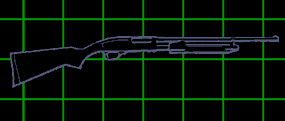
|
Weight: 7.2 lbs (3.2kg)
Price Range: C16000-18000
Damage Modifier: vs Armored Targets - x6
vs Soft Targets - x20
|
Type: Pump-Action Shotgun
Range: Eff. - 50 feet (15m)
Magazine Capacity: 4-Round Internal
(+1 In Chamber),
12 Gauge Shell
|
The most widely-used shotgun and possibly gun of any kind ever made is the
Remington 870 Express. First appearing in the 1950's, millions of these
shotguns have been produced in many variants over its 85-year production
run, from civilian hunting versions to police and military tactical models.
Thousands of custom parts, modifications, and accessories for this shotgun
were widely manufactured and sold in mass quantities, largely unregistered.
Thus, it is still practical to obtain just about any version of the gun
desired, despite restrictions on private gun ownership.
Many police agencies have been willing to "look the other way" when it comes
to restrictions on shotguns, even in Americorp where stringent laws are the
norm, most especially in rural areas. The 870 Express shows no sign of going
away anytime.
|
|
Kalashnikov AK-173 Assault Rifle
|

|
Weight: 12.4 lbs (5.6kg)
Price Range: C29000-31000
Damage Modifier: x18
|
Type: Caseless Assault Rifle
Range: Eff. (Point) - 1804 feet (550m)
(Area) - 2624 feet (800m)
Max. - 9840 feet (3000m)
Magazine Capacity: 40-Round Clip,
10mm Americorp
|
The latest model of the two century-old Kalashnikov assault rifle tradition,
the AK-173 was developed to replace the cased round weapons of the AK-133
previously used in Russian-backed nations. It is the cheapest assault rifle
still produced, and while not particularly accurate, it is highly reliable.
The rifle was manufactured in staggering numbers, made from inexpensive
materials including pig iron, recycled plastics, and wood.
Produced in a massive run for Russian use and for export, it is estimated
that at least 70% of the original rifles are still in use throughout the
world. No new AK-173 rifles have been produced since the original line
closed down, but a glut of spare parts and foreign copies ensure that the
weapon will remain in world service and on the black market for quite some
time.
|
|
Fabrique Nationale FN-122 Assault Rifle
|
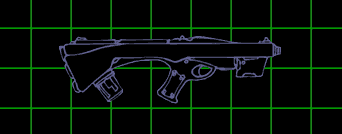
|
Weight: 8.6 lbs (3.9kg)
Price Range: C53000-59000
Damage Modifier: x15
|
Type: Caseless Assault Rifle
Range: Eff. (Point) - 2460 feet (750m)
(Area) - 3610 feet (1100m)
Max. - 10004 feet (3050m)
Magazine Capacity: 35-Round Clip,
10mm Eurocorp
|
Designed and fielded circa 2029, the FN-122 is one of the longest-serving
weapons still used and one of the earliest second generation caseless
weapons ever to be mass-produced. The performance of current FN-122s have
been greatly improved but are still fundamentally the same weapon as the one
carried by Eurocorp troops 70 years ago, a commonly-recognized symbol of
21st century European might.
The series evolved through three major production runs, or "blocks," with
improvements made at each iteration. Subsequent to each block, replacement
kits were made available, converting the majority of the previous block to
the upgraded version, making it rare to find an "original" FN-122.
The current block is link-capable, but though the improvement is dramatic
over previous FN-122 blocks, the result is not quite as good as weapons
designed from the ground up to accept links. Still, the FN-122 is a very
respectable combat rifle, and is widely used throughout the world.
|
|
Tauron MD94 Assault Rifle
|
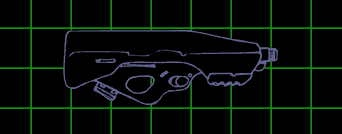
|
Weight: 8.0 lbs (3.6kg)
Price Range: C50000-65000
Damage Modifier: x18
|
Type: Caseless Assault Rifle
Range: Eff. (Point) - 3280 feet (1000m)
(Area) - 4590 feet (1400m)
Max. - 10496 feet (3200m)
Magazine Capacity: 50-Round Clip,
20mm Americorp
|
Developed in 2094, the MD94 represents the culmination of "lessons-learned"
from several previous Tauron assault models which, though functionally
similar, are not directly related to one another. Firing 20mm caseless, the
weapon has a high level of "soldier-proof" reliability, and is considered
the premier model assault rifle employed anywhere in the world today.
The MD94 was developed independently to fill the lack of weaponry
specifically made to handle the advanced features of the modern smart-link.
All of its features are manageable via the link, and run on a
kinetically-charged battery. The MD94 interfaces with a vast array of
link-connectable systems, and can be upgraded to accept new devices through
the link.
The weapon may optionally be identa-locked to limit use to a single user
using alphanumeric code, DNA, electromagnetic patterns, fingerprint match,
and skin chemistry, or any combination. This feature is common to weapons in
service with police forces.
The MD94 can also be tripod-, bipod-, turret-, or vehicle-mounted and can be
linked to Americorp automatic fire control systems.
|
|
20mm Caseless Non-Lethal/Specialized Rounds
|
Weight: N/A
Price Range: Varies (See description)
Damage Modifier: Special (See description)
|
Type: Round
Range: N/A
Capacity: N/A
|
The use of 20mm rounds in Americorp long weapons, especially the MD94,
allows great flexibility in the design of such a large caliber projectile.
Besides the hard-hitting ball, hollow point, and armor piercing rounds most
commonly used in 20mm weapons, several special purpose munitions are also
available:
M4460 Riot Gas -C65-85- On impact, the plastic-cased round shatters into
tiny particles and disperses a cloud of oxidizing irritant chemicals. A
small cloud of riot gas is then created in a small area around the site
of impact. Used in mass, these rounds can create a large cloud of gas in
a short time. The M4460A2 round is identical, except it has a penetrator
to allow it to go through thin barriers such as doors before dispersing
gas. Hits on a person with a penetrator round should be the same as with
a normal bullet.
M4461 Caustic Agent/Ferret -C80-110- This round explodes open on impact,
releasing a small amount of caustic chemical that begins dissolving
materials beneath it. Typically, this round contains enough chemical to
eat away a door latch or lock before breaking down into harmless
chemical compounds.
M4465 Plastic -C10-15- Designed for riot control, these plastic bullets
quickly deform and disperse their energy without entering the body or
causing dangerous injuries, though they are very painful.
M4466 Fin Stabilized Baton -C60-85- Another riot control or submission
round, this fin-stabilized bullet deploys tiny fins after being fired to
ensure that its dull rubber point impacts accurately on target. Unlike
plastic bullets, the baton round can be deadly if it strikes a vital
area such as the head or groin because it is heavier and displaces much
more energy. However, they can be more effective than plastic bullets
for this same reason.
|
|











